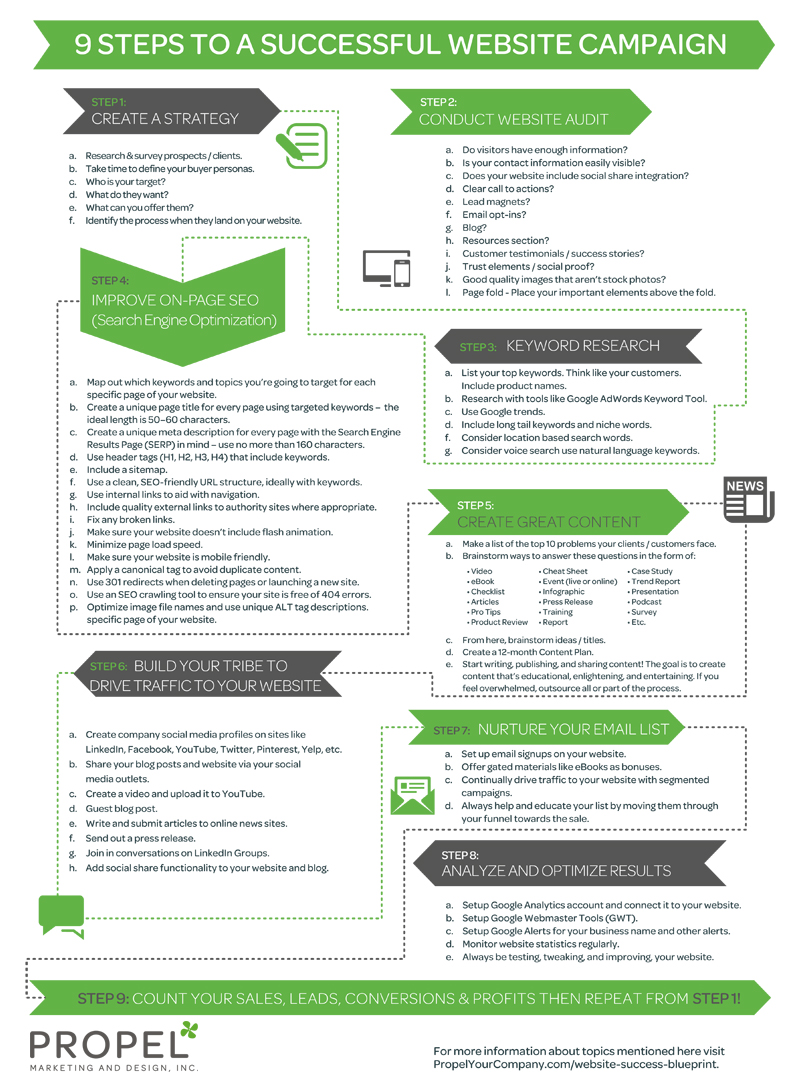Long gone are the days when you can simply copy your company brochure to your website, sit back and expect to reap the rewards of climbing to the top of Google.
In the ever so overpopulated online space, you have to do more than just have a website that serves the basic needs. So, today we’re taking looking at what it takes to have (and run) a successful website campaign (or at least the 30,000 view of what it takes).
So, who is this for/ when should you use it?
- If you’re about to launch a website for the first time
- If you’re about to do a website redesign or in the process
- If you’re considering adding a new product, service, market, etc.
- If you have a website but would like to see better performance
In other words, I think we can all take a look at this blueprint and ask, “What can we do better to improve our website campaign?”
Here are 9 Steps to a Successful Website Campaign
Click the image to make it larger. Click here for printable version.
To make this easy for you, here’s a link to a downloadable easy-to-print size version of the 9-step blueprint. Also, if you would like to share the infographic size version of the graphic, please feel free to do so, just make sure that you link back to the original source for credit or use the code below it to embed it on your website.
Successful Website Campaign Step 1: Create a Strategy
I think that most businesses sit down and strategize about their websites and what they want to offer, highlight, etc., on the site, but not some miss the mark by truly taking the time to identify their buyer personas and identify how they’re going to connect with each persona on the site and throughout the website.
Create a Strategy:
- Research & survey prospects / clients.
- Take time to define your buyer personas. You can find a complete guide to buyer personas here. Buyer personas are fictional representations of your ideal customer. Buyer personas go by many names; you may have heard them called customer avatar, ICA (ideal customer avatar), customer persona, buyer profile, target customer, etc.
- Who is your target?
- What do they want?
- What can you offer them?
- Identify the process when they land on your website.
Successful Website Campaign Step 2: Conduct a Website Audit
During this stage conduct a website content audit. For more details, sift through Google Analytics or another analytics system to get a more detailed look at what visitors are doing on your website (links to analytics programs are provided in step 8). This method gives a complete insight into any website, overall traffic, and individual pages. The goal is to detect any weak points in your campaign.
Conduct a Website Audit:
- Do visitors have enough information?
- Is your contact information easily visible?
- Does your website include social share integration?
- Clear call to actions?
- Lead magnets?
- Email Opt-ins?
- Blog?
- Resources Section?
- Customer Testimonials / Success Stories?
- Trust elements / social proof?
- Good quality images that aren’t stock photos?
- Page Fold – Place your important elements above the fold.
Successful Website CampaignStep 3: Keyword Research
Keyword research is one of the most important, valuable, and high-return activities in the SEO. Here are steps to get you started.
SEO Keyword Research:
- List your top keywords. Think like your customers. Include product names.
- Research with tools like:Google AdWords Keyword ToolGoogle TrendsMicrosoft Bing Ads IntelligenceWordtracker’s Free Basic Keyword DemandMoz Keyword Explorer
- Include long tail keywords. Long tail keywords are more specific and less common.
- Focus on niche words.
- Consider location-based search words.
- Consider voice search / mobile – When using voice search people use longer queries and natural language. Here’s a link to a recent blog post we did on this topic if you want to learn more.
- Go to places like subreddit categories or other niche blogs and forums to find out specific terms people are using.
Successful Website Campaign Step 4: Improve Your On-Page SEO (Search Engine Optimization)
While hiring the right SEO expert can do wonders for a company’s website ranking, so can following some basic fundamental best practices when it comes to SEO. If you’re using WordPress, you can use a Plugin like Yoast SEO to help you with some of the items outlined below. Just (please, please, please) remember just because you have a plugin installed on your website doesn’t mean it’s doing the work for you. If you’re using an SEO plugin like Yoast SEO, you still want to go page-by-page and post-by-post and fill out items like page meta descriptions.
Improve Your On-Page SEO (Search Engine Optimization):
- Map out which keywords and topics you’re going to target for each specific page of your website.
- Create a unique page title for every page using targeted keywords – the ideal length is 50–60 characters.
- Create a unique meta description for every page with the Search Engine Results Page (SERP) in mind – use no more than 160 characters.
- Use header tags (H1, H2, H3, H4) that include keywords.
- Include a sitemap. – If you’re using Yoast SEO, make sure you actually turn this on. It’s not automatic.
- Use a clean, SEO-friendly URL structure, ideally with keywords.
- Use internal links to aid with navigation.
- Include quality external links to authority sites where appropriate.
- Fix any broken links.
- Make sure your website does not include flash animation or nested frames.
- Minimize page load speed. See how Google thinks your website loads with Google PageSpeed Insights > https://developers.google.com/speed/pagespeed/insights/
- Make sure your website is mobile-friendly.
- Apply a canonical tag to avoid duplicate content.
- Use 301 redirects when deleting pages or launching a new site.
- Use an SEO crawling tool to ensure your site is free of 404 errors.
- Optimize image file names and use unique ALT tag descriptions.
Successful Website Campaign Step 5: Create Contagious Content
If you’re looking for a great article on content, jump over to our Content Marketing Planning Template. It’s structured to help you think through the dimensions of different content based on how your audience might think and what you’re trying to achieve as a business.
Create Contagious Content:
- Make a list of the top 10 problems your clients / customers face.
- Brainstorm ways to answer these questions in the form of:
- Video
- eBook
- Checklist
- Articles
- Pro Tips
- Product Review
- Cheat Sheet
- Event (live or online)
- Training
- Infographic
- Press Release
- Pricelist
- Report
- Case Study
- Trend Report
- Presentation
- Podcast
- Survey
- White Paper
- Blueprint
- Calculator
- Trends
- Demo
- Community Forum
- Etc.
- From here, brainstorm ideas / titles.
- Create a 12-month Content Plan (break it down as needed for your business – daily, weekly, monthly, quarterly, bi-annually, & annually).
- Start writing, publishing, and sharing content! The goal is to create content that’s educational, enlightening, and entertaining. If you feel overwhelmed, outsource all or part of the content creation process.
Successful Website Campaign Step 6: Build Your Online Tribe to Drive Traffic to Your Website
Now that you’ve created some amazing content, it’s time to share it with your online tribe. Keep in mind being on social media should be about being “social”, not just about boasting your own company. So while it’s key to share information through your social channels make sure you’re not making it all about “you.”
Build Your Online Tribe to Drive Traffic to Your Website:
- Create Company social media profiles on sites like LinkedIn, Facebook, YouTube, Twitter, Pinterest, Yelp, etc.
- Share your blog posts and website via your social media outlets.
- Create a video and upload it to YouTube.
- Guest blog post.
- Write and submit articles to online news sites.
- Send out a press release.
- Join in conversations on LinkedIn Groups.
- Add social share functionality to your website and blog.
Successful Website Campaign Step 7: Nurture Your Email List
The people on your email list have already to said that they want to hear from you. Now it’s time to deliver.
Nurture Your Email List:
- Set up email signups on your website.
- Offer gated materials like eBooks as bonuses (or other items mentioned in step #5).
- Continually drive traffic to your website with segmented campaigns.
- Always be helping and educating your list by moving them through your funnel towards the sale.
Successful Website Campaign Step 8: Analyze and Optimize Results
Setting up analytics on your website will help you measure, monitor, and understand website traffic.
Analyze and Optimize Results:
- Setup Google Analytics account and connect it to your website.
- Setup Google Webmaster Tools (GWT). GWT is a free toolset provided by Google that helps you first understand what’s going on with your website.
- You can set up Clicky (similar to Google Analytics – but simpler to use).
- Setup Google Alerts for your business name and other alerts.
- Monitor website statistics regularly.
- Always be testing, tweaking, and improving your website.
Successful Website Campaign Step 9: Repeat
It’s a process…
Repeat:
- Count your sales, leads, conversions, & profits, then
- Repeat from Step 1!













![How to Write a Professional Chiropractic Bio [Template Included]](https://propelyourcompany.com/wp-content/uploads/write-a-bio-500x383.jpg)
